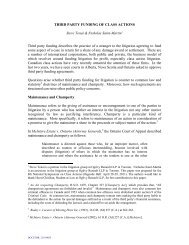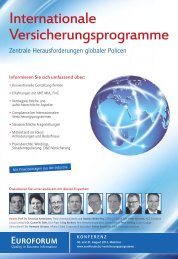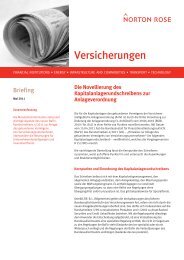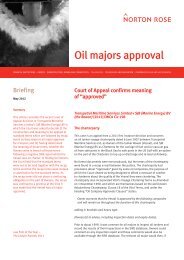The Act Implementing the AIFM Directive - Norton Rose
The Act Implementing the AIFM Directive - Norton Rose
The Act Implementing the AIFM Directive - Norton Rose
You also want an ePaper? Increase the reach of your titles
YUMPU automatically turns print PDFs into web optimized ePapers that Google loves.
1.4 Scenarios<br />
Besides <strong>the</strong> aforementioned explicit exemptions and <strong>the</strong> exemptions which are at least<br />
mentioned in <strong>the</strong> explanatory comments to <strong>the</strong> law, <strong>the</strong>re are fur<strong>the</strong>r scenarios outside <strong>the</strong><br />
scope of <strong>the</strong> KAGB-E.<br />
1.4.1 Structured products<br />
Characteristic to structured products is that an issuer issues a cash instrument in which a<br />
(basic or complex) derivative is embedded. Often − but not necessarily − credit institutions<br />
act as issuers. Since, as a consequence of <strong>the</strong> financial crisis investors are not always<br />
permitted to have a (high) credit exposure to a single credit institution, single purpose<br />
vehicles (SPV) are also frequently used as issuers. Cases where credit institutions act as<br />
issuers obviously do not fall within <strong>the</strong> scope of <strong>the</strong> KAGB-E, as, due to <strong>the</strong>ir operating<br />
activities, credit institutions cannot qualify as an investment asset pool.<br />
Moreover, <strong>the</strong> KAGB-E does not apply to situations where a SPV acquires, for example,<br />
investment fund units, issues structured or hybrid products (delta-1 certificates or<br />
participation rights or certificates) with respect <strong>the</strong>reto, and <strong>the</strong>n provides such investment<br />
fund units to investors as collateral against <strong>the</strong> possibility that <strong>the</strong> SPV fails to duly comply<br />
with its obligations under <strong>the</strong> certificates or o<strong>the</strong>r instruments. However, <strong>the</strong> fact that <strong>the</strong><br />
KAGB-E does not apply to <strong>the</strong>se cases certainly requires a more detailed explanation.<br />
As regards participation rights, <strong>the</strong> legislator has expressly provided for <strong>the</strong> non-applicability<br />
of <strong>the</strong> KAGB-E by amending section 1 sub-section 2 of <strong>the</strong> Capital Investment <strong>Act</strong><br />
(Vermögensanlagegesetz – VermAnlG) by Article 4 of <strong>the</strong> Draft Bill. <strong>The</strong> new wording is as<br />
follows (freely translated and amendments shown in italics):<br />
(2) Capital investments within <strong>the</strong> meaning of this <strong>Act</strong> are:<br />
1 shares granting a participation in <strong>the</strong> profit or loss of an undertaking;<br />
2 shares in a pool of assets held or managed by <strong>the</strong> issuer or a third party in its own<br />
name for <strong>the</strong> account of o<strong>the</strong>rs (trust assets);<br />
3 units in o<strong>the</strong>r closed-ended funds;<br />
4 participation rights; and<br />
5 registered bonds,<br />
<strong>The</strong> <strong>Act</strong> <strong>Implementing</strong> <strong>the</strong> <strong>AIFM</strong> <strong>Directive</strong><br />
which are not represented by securities within <strong>the</strong> meaning of <strong>the</strong> WpPG and not structured<br />
as shares in investment asset pools within <strong>the</strong> meaning of section 1 sub-section 1 KAGB.<br />
On page 559 of <strong>the</strong> Draft Bill, <strong>the</strong> above amendment is explained as follows (freely translated):<br />
“This amendment ensures that <strong>the</strong> Capital Investment <strong>Act</strong> (Vermögensanlagengesetz)<br />
henceforth only applies to capital investments, which are not subject to <strong>the</strong> new<br />
provisions of <strong>the</strong> Capital Investment Code; this may apply, in particular, to participation<br />
rights and registered bonds.”<br />
Thus, it is explicitly stated that, as a general rule, participation rights are not treated as fund<br />
units.<br />
<strong>Norton</strong> <strong>Rose</strong> December 2012 11













